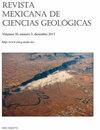Holocene and Upper Pleistocene stratigraphy of Xochimilco lake, central Mexico
IF 0.5
4区 地球科学
Q4 GEOSCIENCES, MULTIDISCIPLINARY
Revista Mexicana De Ciencias Geologicas
Pub Date : 2022-07-26
DOI:10.22201/cgeo.20072902e.2022.2.1687
引用次数: 1
Abstract
The lacustrine system developed in the basin of Mexico has been of great interest in studies of various geological and social disciplines. Its sediments preserve the history of the environmental changes that occurred during the late Quaternary. Between 2016 and 2018, a set of lacustrine sediment cores were collected in the Xochimilco sub-basin, located south of the basin of Mexico. From these sedimentary sequences, a master sequence was constructed that represents the upper 66.5 m of the lacustrine deposits. For the establishment of its stratigraphic column, 15 lithotypes were defined from their sedimentary components in which the clastic components made up of silicates dominate, mostly silt and clay in size. The most abundant biogenic fraction is diatoms that frequently form oozes, and ostracods are a common component in most of the sequence, which locally form hashes. Interbedded with the clastic and biogenic lithotypes are volcaniclastic deposits. Eight lithological units were defined based on their dominant lithotypes. The time scale of the sequence is still uncertain for the oldest sediments; however, it is estimated that it covers the last 300000 to 350000 years. From this temporality, environmental oscillations of millennial scales are inferred. Diatom-rich laminated sediments represent the deepest phases in the lake. The deposits with higher biogenic and authigenic calcareous components indicate the phases of higher ionic concentration during which the lake was shallower. The detailed analysis of the stratigraphy and the description of the sedimentary components in Xochimilco allows to establish an initial interpretation of the variations in the depositional environments, and provides the base from which the detailed studies of paleoclimatic indicators will be supported.墨西哥中部科奇米尔科湖全新世和上更新世地层
墨西哥盆地发育的湖泊体系一直是各地质和社会学科研究的热点。它的沉积物保存了晚第四纪环境变化的历史。2016年至2018年间,在位于墨西哥盆地南部的霍奇米尔科次盆地收集了一组湖泊沉积物岩心。在此基础上,构建了代表湖相沉积上部66.5 m的主层序。根据沉积组分划分出15种岩型,其中碎屑组分以硅酸盐为主,粉砂质和粘土为主。最丰富的生物组分是硅藻,经常形成软泥,介形虫是大多数序列中的常见成分,它们在局部形成散列。与碎屑岩型和生物岩型互层的是火山碎屑岩矿床。根据优势岩性划分出8个岩性单元。对于最古老的沉积物,序列的时间尺度仍然不确定;然而,据估计,它覆盖了过去的30万到35万年。从这一时间性可以推断出千禧年尺度的环境振荡。富含硅藻的层状沉积物代表了湖的最深阶段。生物钙和自生钙含量较高的沉积物表明,在离子浓度较高的阶段,湖泊较浅。通过对霍奇米尔科地层的详细分析和沉积组分的描述,初步解释了该地区沉积环境的变化,为进一步开展古气候指标的详细研究奠定了基础。
本文章由计算机程序翻译,如有差异,请以英文原文为准。
求助全文
约1分钟内获得全文
求助全文
来源期刊

Revista Mexicana De Ciencias Geologicas
地学-地球科学综合
CiteScore
1.00
自引率
12.50%
发文量
0
审稿时长
6-12 weeks
期刊介绍:
Revista Mexicana de Ciencias Geológicas (RMCG) publishes original research papers on geological processes of broad interest, and particularly those dealing with regions of Latin America. The RMCG also publishes review papers on topics of current interest, and on the geology and tectonics of geological provinces of Latin America. Besides, it offers the opportunity for host editors to publish special thematic issues.
 求助内容:
求助内容: 应助结果提醒方式:
应助结果提醒方式:


